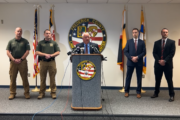High blood pressure, or hypertension, is often considered a “silent killer” because it doesn’t cause obvious signs or symptoms that individuals or doctors can readily identify by observation alone.
“Most people who have high blood pressure don’t actually know that they have it,” says Dr. Nandita Scott, co-director of the Women’s Heart Health Program at Massachusetts General Hospital in Boston. “That’s why it’s so important to schedule annual physical exams to get blood pressure checked.”
High blood pressure is common. According to the Centers for Disease Control and Prevention, nearly half of American adults — equivalent to 116 million people — have hypertension. Around the world, this condition affects 1.28 billion adults aged 30 to 79. However, because of the stealthy nature of the condition, approximately 46% of adults with hypertension don’t know they have the condition and 42% are diagnosed and treated, based on 2021 estimates from the World Health Organization.
If high blood pressure isn’t caught and controlled, it can eventually increase your risk of heart disease and stroke, two of the leading causes of death in the United States.
Unfortunately, early detection for high blood pressure suffered during the COVID-19 pandemic. According to a 2022 study published in the journal Hypertension, management of high blood pressure declined during COVID-19. The analysis, led by researchers at Cedars-Sinai Medical Center in Los Angeles, showed that high blood pressure was measured less frequently among people diagnosed with the condition during the first eight months of the pandemic, leading people with high blood pressure to fare worse in terms of severe illness, hospitalization and death.
Thankfully, regular blood pressure checks — at annual health care visits or at the pharmacy — can spot high blood pressure, prevent or pinpoint medical problems and pave the way for a treatment plan.
[Read: How to Properly Take and Read Your Blood Pressure at Home.]
What Is High Blood Pressure?
Your arteries are the blood vessels that transport blood from your heart to the rest of your body. As part of normal circulation, every heartbeat pushes blood through the arteries, creating pressure on the artery walls. Blood pressure naturally increases and decreases throughout the day. However, when blood pressure is too high, it puts stress on your heart and can lead to damage of the arteries and organs.
A blood pressure reading includes two components:
— Systolic. Your systolic blood pressure is the top number in a blood pressure reading. For example, the 120 in 120/80 millimeters of mercury (mm Hg). The systolic represents the highest blood pressure in your arteries, while the heart is pushing blood out to the body.
— Diastolic. Your diastolic blood pressure is the bottom number in a blood pressure reading. For example, the 80 in 120/80 mm Hg. The diastolic represents the lowest blood pressure in your arteries, while your heart is relaxed.
[READ: Stroke vs. Heart Attack: How to Tell the Difference]
What Constitutes High Blood Pressure?
High blood pressure isn’t diagnosed by a single reading, but rather as a pattern. Blood pressure is classified in the following stages for adults:
| Blood Pressure Level | Systolic (mm Hg) | Diastolic (mm Hg) |
| Normal | Less than 120 | and less than 80 |
| Elevated | 120-129 | and less than 80 |
| Hypertension stage 1 | 130-139 | or 80-89 |
| Hypertension stage 2 | 140 or higher | or 90 or higher |
| Hypertensive crisis | Higher than 180 | and/or higher than 120 |
Typically, both numbers are high, but in isolated diastolic hypertension, an uncommon form, only the diastolic blood pressure is high.
Currently, there are no gender-specific blood pressure targets. According to the American Heart Association’s 2021 Heart Disease and Stroke Statistics report, the prevalence of high blood pressure is 51.7% in males and 42.8% in females.
Until boys and girls hit puberty, blood pressure remains similar between the sexes, and while the overall prevalence is higher among males, there is a significantly steeper rate at which females develop high blood pressure as they age.
Blood pressure classifications are established by the American College of Cardiology and the American Heart Association. In 2017, previous blood pressure stages were lowered to the current numbers in recognition that even stage 1 blood pressure can damage health over time and, therefore, needs to be treated.
[READ: Understanding Blood Flow Restriction]
Signs of High Blood Pressure
While the terms “signs” and “symptoms” are often used interchangeably to describe a condition, they — in fact — have two distinct definitions. A sign is a disease manifestation that doctors or other clinicians can perceive. A symptom is a disease manifestation that patients notice themselves. It’s rare to detect high blood pressure by symptoms alone.
“There are no signs of high blood pressure,” says Dr. Willie Lawrence, Jr., a cardiologist at Lakeland Heart and Vascular in St. Joseph, Michigan. “When you start having signs of hypertension, that means you already have end-organ damage, so this is not a disease that can wait for signs and symptoms.”
Signs of persistently high, untreated blood pressure may include:
— Decreased vision. This can be due to damage to the retina, a part of the eye, from a condition called hypertensive retinopathy.
— Mini-strokes. One-sided numbness or weakness, difficulty with speaking or understanding others, difficulty with walking or balance are symptoms.
— Numbness. Some people may experience a loss of feeling in their fingertips or toes if peripheral vascular disease develops.
— Kidney damage. This may not cause symptoms, but can progress to the point where people need dialysis.
Beyond increasing your risk of heart disease and stroke, persistently high blood pressure can cause significant damage to vital organs in your body, including your heart, brain, kidneys and eyes. Unfortunately, notable high blood pressure symptoms tend to occur from long-term damage to various parts of the body.
“It just depends on how long someone’s had hypertension,” says Dr. Anjali Mahoney, chief medical officer for the Venice Family Clinic in Los Angeles. “People can have high blood pressure for a long time and end up with end-stage organ damage before they even know they have hypertension. Sometimes organ damage is the first presentation. Someone will end up with a stroke, and you realize that they had hypertension.”
That’s why it’s important for patients to establish a relationship with a primary care provider to lower their risk of serious health problems.
What Causes High Blood Pressure?
Causes of high blood pressure in an individual patient aren’t always clear, but the condition is more likely with certain risk factors:
— Age. Because blood pressure naturally increases as you age, your risk for developing high blood pressure goes up as you get older. “As you age, it’s not enough to check your blood pressure when you’re 40. You really should have it checked yearly,” Lawrence says.
— Diabetes. Approximately 60% of people who have diabetes also have hypertension.
— Race or ethnicity. Black people are more likely to develop hypertension than other racial groups.
— Family history. There are a number of genes associated with higher blood pressure. However, because there are so many genes involved in blood pressure regulation it is still complicated to predict who might develop it. “Nevertheless, if it runs in your family, you are at higher risk of developing high blood pressure,” says Dr. Stephen Juraschek, research director of the Hypertension Center at Beth Israel Deaconess Medical Center in Boston.
— Being overweight or having obesity. The heart muscle works harder to pump blood and oxygen that will circulate throughout the body, causing additional stress on your heart and arteries.
— Being sedentary or physically inactive. Regular physical activity strengthens your heart and arteries and helps you manage a healthy weight. Without it, your blood vessels will harden and develop plaque buildup, making your heart work harder to circulate blood.
— Smoking. Blood pressure temporarily increases each time you smoke. Smoking and secondhand smoke can increase plaque buildup in the blood vessels.
— Alcohol overuse. Consuming too much alcohol can increase your blood pressure.
— Unhealthy diet. Diets that are too high in sodium and too low in potassium increases your risk for high blood pressure.
Certain medical conditions can cause or contribute to high blood pressure:
— Renal hypertension. In this kidney disease, the arteries that transport blood to the kidneys are narrowed, which reduces circulation to the organ. In response, the kidneys make a hormone that causes the blood pressure to rise.
— Hormonal problems. Hyperthyroidism, or too much thyroid hormone, may cause high blood pressure. Cushing’s syndrome, or overactive adrenal glands, may cause high blood pressure too.
— Sleep apnea. When untreated, sleep apnea can lead to high blood pressure. Treating sleep apnea with continuous positive airway pressure (CPAP) can help reverse it.
— Diabetes. People who have diabetes are more likely to develop high blood pressure, but the reason for this is uncertain.
High Blood Pressure Urgency
It’s imperative that blood pressure be measured on a regular basis.
“You want to know what your blood pressure is in time for it not to have done damage to your body,” Lawrence says.
Unfortunately, lack of monitoring is a major concern.
“If you go to a physician’s office or other health care provider’s office, you will have your blood pressure monitored,” Lawrence says. “Part of the problem is that people who are at the greatest risk don’t go to the doctor’s office. They don’t check their blood pressure frequently enough.”
Mahoney echoes concern over missed hypertension, especially in men.
“Men are more likely not to want to go to the doctor,” she says. “It’s important that anyone, but specifically men, go and see a primary care clinician at least once a year.”
In late 2020, the American Heart Association launched the National Hypertension Control Initiative to address gaps in managing high blood pressure, specifically to improve COVID-19-related health outcomes among racial and ethnic minority populations. With federal funding, the collaboration between the American Heart Association and partners is raising awareness of high blood pressure and promoting its prevention in a multipronged community approach.
The U.S. Preventive Services Task Force recommends annual screening for hypertension in adults 40 years or older and for adults at increased risk for high blood pressure, including people with high-normal blood pressure, Black and African American individuals and those who are overweight or obese.
High Blood Pressure Treatment
Effective treatment for high blood pressure is available and affordable. Medication and lifestyle changes can help most people manage their blood pressure.
High blood pressure medication
Getting doctors to prescribe accordingly and patients to adhere to treatment recommendations is a public health challenge. In January 2022, the medical journal Hypertension published an American Heart Association scientific statement on medication adherence and blood pressure control.
A variety of factors contribute to the gap between blood pressure goals and adherence to recommendations, says Dr. Wanpen Vongpatanasin, director of the Hypertension Section at University of Texas Southwestern Medical Center in Dallas and an AHA statement co-author. For example, hypertension may be better controlled for some patients by using more than one medication. However, patients might be concerned about side effects or not see the need to take additional drugs, Vongpatanasin says. Physicians might hesitate to add yet another drug to a patient’s medication regimen.
That’s why a collaborative relationship between doctors and patients is so important for chronic disease management, Vongpatanasin says, to continually watch for side effects, adjust medications as needed and accommodate patients’ needs or lifestyle barriers to treatment.
Lack of symptoms is one reason patients might not perceive the need to take blood pressure medication.
“It’s easier to get patients to take cold syrup when they’re sick than it is to take a pill every day when they don’t feel anything,” Lawrence says. “One of the challenges of managing hypertension is getting people to understand that once you have the symptoms or signs (they) represent the fact that hypertension has done its damage and your efforts are no longer just preventive.”
The good news is that timely treatment works.
“Blood pressure can actually be improved pretty quickly,” Vongpatanasin says. “Even with once-a-day regimens, you can see maximum effects within a few weeks. Within a week, you can see things starting to improve.”
Lifestyle changes to lower blood pressure
You can take non-medication steps to help keep blood pressure under control. Natural ways to lower blood pressure include:
— Lose weight. Taking off a moderate 10-20 pounds or so can reduce your blood pressure numbers. This is recommended while keeping a healthy weight in mind.
— Exercise. Adding physical activity and aerobic exercise to usual care may reduce blood pressure even in people with hard-to-treat hypertension, according to a systematic review published in April 2022.
— Curb alcohol. Drinking less can help prevent high blood pressure. The American Heart Association recommends limiting your alcohol intake to no more than two drinks per day for men and no more than one drink per day for women.
— Follow a healthy diet. The DASH diet — which stands for dietary approaches to stop hypertension — is a proven way to control blood pressure. In general, eating vegetables and other plant foods helps.
— Limit salt. Some people are particularly salt-sensitive — their blood pressure rises as they consume more salt. You can cut salt while cooking, grocery shopping and eating out.
— Quit smoking. Hypertension can be a consequence of long-term smoking. Talk to your doctor about smoking cessation.
— Increase potassium. If you have low potassium, consuming potassium-rich foods, such as bananas and tomatoes, can help reduce high blood pressure. However, this is not recommended for people with abnormal kidney function.
While lifestyle changes can help reduce your blood pressure and improve your overall well-being, you might still need to take blood pressure-lowering medication.
Taking Blood Pressure Properly
Blood pressure readings — both at doctors’ offices and at home — must be taken correctly for the most reliable results. Blood pressure-taking tips include:
— Be seated in a chair.
— Sit quietly for five minutes or so to relax.
— For the reading, sit upright with your back supported and your feet on the floor.
— Your arm should be supported at heart level, by resting it on a countertop or table.
— Place the cuff over bare skin, not a sleeve.
You need a reliable blood pressure monitor to ensure accurate readings. Developed by the American Medical Association, the U.S. Blood Pressure Validated Device Listing features devices that have been independently evaluated and met criteria for clinical accuracy. You can access the listing at validatebp.org and filter it for home devices.
More from U.S. News
Drugs That Can Threaten Heart Health
Signs of a Bad Heart: Don’t Overlook These Cardiac Symptoms
How to Spot the Signs of High Blood Pressure originally appeared on usnews.com
Update 02/09/23: This story was published at an earlier date and has been updated with new information.







